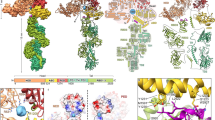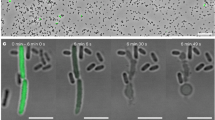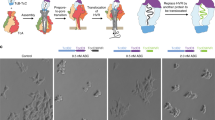Abstract
Photorhabdus luminescens is an insect pathogenic bacterium that is symbiotic with entomopathogenic nematodes1. On invasion of insect larvae, P. luminescens is released from the nematodes and kills the insect through the action of a variety of virulence factors including large tripartite ABC-type toxin complexes2 (Tcs). Tcs are typically composed of TcA, TcB and TcC proteins and are biologically active only when complete3,4,5. Functioning as ADP-ribosyltransferases, TcC proteins were identified as the actual functional components that induce actin-clustering, defects in phagocytosis and cell death5,6,7. However, little is known about the translocation of TcC into the cell by the TcA and TcB components. Here we show that TcA in P. luminescens (TcdA1) forms a transmembrane pore and report its structure in the prepore and pore state determined by cryoelectron microscopy. We find that the TcdA1 prepore assembles as a pentamer forming an α-helical, vuvuzela-shaped channel less than 1.5 nanometres in diameter surrounded by a large outer shell. Membrane insertion is triggered not only at low pH as expected, but also at high pH, explaining Tc action directly through the midgut of insects8. Comparisons with structures of the TcdA1 pore inserted into a membrane and in complex with TcdB2 and TccC3 reveal large conformational changes during membrane insertion, suggesting a novel syringe-like mechanism of protein translocation. Our results demonstrate how ABC-type toxin complexes bridge a membrane to insert their lethal components into the cytoplasm of the host cell. We believe that the proposed mechanism is characteristic of the whole ABC-type toxin family. This explanation of toxin translocation is a step towards understanding the host–pathogen interaction and the complex life cycle of P. luminescens and other pathogens, including human pathogenic bacteria, and serves as a strong foundation for the development of biopesticides.
This is a preview of subscription content, access via your institution
Access options
Subscribe to this journal
Receive 51 print issues and online access
$199.00 per year
only $3.90 per issue
Buy this article
- Purchase on Springer Link
- Instant access to full article PDF
Prices may be subject to local taxes which are calculated during checkout




Similar content being viewed by others
Accession codes
Data deposits
The coordinates for the electron microscopy structures have been deposited in EMDataBank under accession codes EMD-2297 to EMD-2301.
References
Joyce, S. A., Watson, R. J. & Clarke, D. J. The regulation of pathogenicity and mutualism in Photorhabdus. Curr. Opin. Microbiol. 9, 127–132 (2006)
ffrench-Constant, R. H. & Bowen, D. J. Novel insecticidal toxins from nematode-symbiotic bacteria. Cell. Mol. Life Sci. 57, 828–833 (2000)
Waterfield, N. R., Bowen, D. J., Fetherston, J. D. & Perry, R. D. &. ffrench-Constant, R. H. The tc genes of Photorhabdus: a growing family. Trends Microbiol. 9, 185–191 (2001)
Sheets, J. J. et al. Insecticidal toxin complex proteins from Xenorhabdus nematophilus: structure and pore formation. J. Biol. Chem. 286, 22742–22749 (2011)
Lang, A. E. et al. Photorhabdus luminescens toxins ADP-ribosylate actin and RhoA to force actin clustering. Science 327, 1139–1142 (2010)
Lang, A. E., Schmidt, G., Sheets, J. J. & Aktories, K. Targeting of the actin cytoskeleton by insecticidal toxins from Photorhabdus luminescens . Naunyn Schmiedebergs Arch. Pharmacol. 383, 227–235 (2011)
Aktories, K., Lang, A. E., Schwan, C. & Mannherz, H. G. Actin as target for modification by bacterial protein toxins. FEBS J. 278, 4526–4543 (2011)
Bowen, D. et al. Insecticidal toxins from the bacterium Photorhabdus luminescens . Science 280, 2129–2132 (1998)
Landsberg, M. J. et al. 3D structure of the Yersinia entomophaga toxin complex and implications for insecticidal activity. Proc. Natl Acad. Sci. USA 108, 20544–20549 (2011)
Young, J. A. T. & Collier, R. J. Anthrax toxin: receptor binding, internalization, pore formation, and translocation. Annu. Rev. Biochem. 76, 243–265 (2007)
Katayama, H. et al. Three-dimensional structure of the anthrax toxin pore inserted into lipid nanodiscs and lipid vesicles. Proc. Natl Acad. Sci. USA 107, 3453–3457 (2010)
Song, L. et al. Structure of staphylococcal α-hemolysin, a heptameric transmembrane pore. Science 274, 1859–1865 (1996)
Geny, B. & Popoff, M. R. Bacterial protein toxins and lipids: pore formation or toxin entry into cells. Biol. Cell 98, 667–678 (2006)
Parker, M. W. & Feil, S. C. Pore-forming protein toxins: from structure to function. Prog. Biophys. Mol. Biol. 88, 91–142 (2005)
Iacovache, I., van der Goot, F. G. & Pernot, L. Pore formation: an ancient yet complex form of attack. Biochim. Biophys. Acta 1778, 1611–1623 (2008)
Eifler, N. et al. Cytotoxin ClyA from Escherichia coli assembles to a 13-meric pore independent of its redox-state. EMBO J. 25, 2652–2661 (2006)
Ramon, E. et al. Critical role of electrostatic interactions of amino acids at the cytoplasmic region of helices 3 and 6 in rhodopsin conformational properties and activation. J. Biol. Chem. 282, 14272–14282 (2007)
Dow, J. A. Extremely high pH in biological systems: a model for carbonate transport. Am. J. Physiol. 246, R633–R636 (1984)
Milstead, J. E. Heterorhabditis bacteriophora as a vector for introducing its associated bacterium into the hemocoel of Galleria mellonella larvae. J. Invertebr. Pathol. 33, 324–327 (1979)
ffrench-Constant, R. et al. Photorhabdus: towards a functional genomic analysis of a symbiont and pathogen. FEMS Microbiol. Rev. 26, 433–456 (2003)
Hohn, M. et al. SPARX, a new environment for cryo-EM image processing. J. Struct. Biol. 157, 47–55 (2007)
Mindell, J. A. & Grigorieff, N. Accurate determination of local defocus and specimen tilt in electron microscopy. J. Struct. Biol. 142, 334–347 (2003)
Adams, P. D. et al. The Phenix software for automated determination of macromolecular structures. Methods 55, 94–106 (2011)
Rusu, M., Starosolski, Z., Wahle, M., Rigort, A. & Wriggers, W. Automated tracing of filaments in 3D electron tomography reconstructions using Sculptor and Situs. J. Struct. Biol. 178, 121–128 (2012)
Pettersen, E. F. et al. UCSF Chimera–a visualization system for exploratory research and analysis. J. Comput. Chem. 25, 1605–1612 (2004)
Acknowledgements
We are grateful to R. S. Goody for continuous support and for comments on the manuscript. We thank I. Vetter for stimulating discussions. This work was supported by the Deutsche Forschungsgemeinschaft grants RA 1781/1-1 (S.R.) and AK 6/22-1 (K.A.) and by Max Planck Society (S.R.).
Author information
Authors and Affiliations
Contributions
A.E.L. and V.P. cloned constructs and purified proteins; D.M. performed pH studies; A.E.L. and R.B. performed and analysed black lipid bilayer assays; C.G. screened samples and collected negative-stain electron microscopy data; C.G. and O.H. collected cryoelectron microscopy data; C.G. processed and refined electron microscopy data; C.G. and S.R. analysed electron microscopy data; K.A. and S.R. designed the study. C.G. and S.R. wrote the paper. All authors discussed the results and commented on the manuscript.
Corresponding author
Ethics declarations
Competing interests
The authors declare no competing financial interests.
Supplementary information
Supplementary Information
This file contains Supplementary Figures 1-14, Supplementary Methods, Supplementary Table 1 and Supplementary References. (PDF 1909 kb)
Cryo-EM structure of the TcdA1 prepore complex
The video shows a simple linear interpolation between the negative stain and cryo-EM reconstruction of TcdA1. The two domains of the outer shell and the central pore are highlighted in green, khaki and yellow, respectively. In the end, the video focuses on the central pore and subsequently on a protomer, depicting the fitted α-helices. (MOV 5964 kb)
Morph between the negative stain EM reconstructions of TcdA1 in prepore and pore state
The video shows the two states in side and cut-away view and a simple linear interpolation between them. (MOV 4966 kb)
Syringe-like mechanism for membrane insertion
(Animated version of Fig. 4). The two domains of the outer shell and the central pore of TcdA1 are depicted in green, khaki and yellow, respectively. The dimeric complex of TcdB2 and TccC3 is depicted in orange. A brown bar indicates the membrane bilayer. (MOV 845 kb)
Rights and permissions
About this article
Cite this article
Gatsogiannis, C., Lang, A., Meusch, D. et al. A syringe-like injection mechanism in Photorhabdus luminescens toxins. Nature 495, 520–523 (2013). https://doi.org/10.1038/nature11987
Received:
Accepted:
Published:
Issue Date:
DOI: https://doi.org/10.1038/nature11987
This article is cited by
-
Stepwise assembly and release of Tc toxins from Yersinia entomophaga
Nature Microbiology (2024)
-
Yersinia entomophaga Tc toxin is released by T10SS-dependent lysis of specialized cell subpopulations
Nature Microbiology (2024)
-
Miticidal activity of Photorhabdus luminescens for controlling two spider mites, Tetranychus urticae and Tetranychus kanzawai, in Carica papaya
BioControl (2023)
-
CRISPR screens in Drosophila cells identify Vsg as a Tc toxin receptor
Nature (2022)
-
Identification and Characterization of an Efficient Phenylalanine Ammonia-Lyase from Photorhabdus luminescens
Applied Biochemistry and Biotechnology (2021)
Comments
By submitting a comment you agree to abide by our Terms and Community Guidelines. If you find something abusive or that does not comply with our terms or guidelines please flag it as inappropriate.



